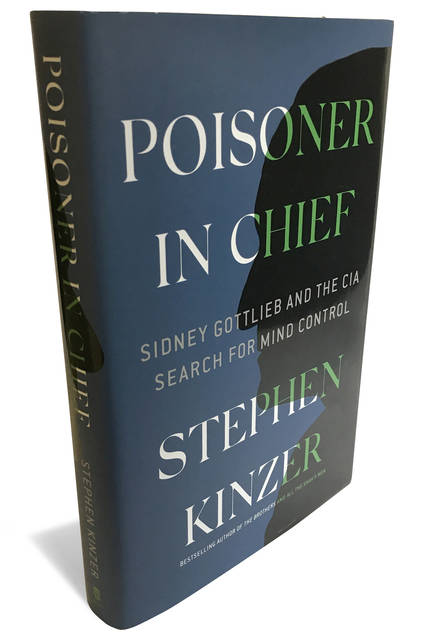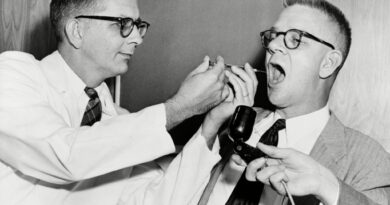‘Poisoner in Chief’ Review: Chemistry Lessons

American scientist Sidney Gottlieb (left) headed the CIA’s MK-Ultra program. He appears here with his attorney in 1977.
Photo: Bride Lane Library/Popperfoto via Getty Images
The general outlines of the story will be familiar to many readers: From 1953 to 1963, the CIA made a wild effort to develop techniques of mind control. The signature program, code-named MK-Ultra, included experiments on both witting and unwitting subjects, many of whom were given large doses of LSD. The program later branched out into poisons, which the CIA attempted, apparently at the White House’s behest, unsuccessfully to use on some foreign leaders, notably Prime Minister Patrice Lumumba of Congo and Fidel Castro of Cuba. A series of articles by Seymour Hersh beginning in 1974 led to investigations by the White House and Congress, resulting in executive orders regulating the CIA and laws subjecting the agency to oversight by Senate and House intelligence committees.
In 1977 the Senate committee published its proceedings, together with transcripts of testimony by CIA Director Stansfield Turner and declassified documents about MK-Ultra. A number of books followed, including John Marks’s “The Search for the ‘Manchurian Candidate’ ” (1979) and Gordon Thomas’s “Journey Into Madness” (1989) and “Secrets and Lies” (2007).
In “Poisoner in Chief,” Stephen Kinzer takes the unusual approach of making Sidney Gottlieb, MK-Ultra’s program manager, the central figure of the story. It was Gottlieb who expanded the program from a small staff with a handful of employees in Washington to a world-wide undertaking with contractors and “officers numbered in the dozens.” He directed much of the work himself.
Mr. Kinzer, a former New York Times bureau chief and current world-affairs columnist for the Boston Globe, describes how the eclectic MK-Ultra program bore the unique stamp of Gottlieb’s personality. The son of Jewish immigrants from Hungary, he was born in 1918 in the Bronx, N.Y., with two club feet that were only partly corrected by surgery, and a stutter that stayed with him for much of his life. He balanced pursuits such as folk dancing and meditation with the hard sciences and obtained undergraduate and graduate degrees in chemistry and biochemistry.

Poisoner in Chief
By Stephen Kinzer
Holt, 354 pages, $30
In 1951, as Cold War tensions ran high, Gottlieb joined the CIA and began a 22-year career during which he quickly rose to the highest civil-service ranks. With a minimum of supervision, he was left to run a program that lacked scientific rigor and routinely violated basic tenets of experimental ethics.
While he could be almost touchingly considerate of his employees, Gottlieb comes across as casually indifferent to the consequences of his work. “He was,” Mr. Kinzer writes, “known as a compassionate boss who made a point of mixing with his subordinates.” At the same time, he also believed that, given the Soviet threat, the end justified the means, and took unconscionable risks with his subjects’ lives.
In the well-known case of Frank Olson, those risks had deadly consequences. Olson, one of the biochemists who worked for Gottlieb on MK-Ultra, either fell or jumped from his 10th-floor New York hotel room in the early hours of Nov. 28, 1953. According to Mr. Kinzer, Olson may have been murdered on account of the doubts he had been harboring about MK-Ultra and the fear that he might go public with its secrets. The author contends that Olson’s was but one of many deaths that occurred under Gottlieb.
In a 1963 report, the CIA’s inspector general finally raised the questions that should have occurred much earlier to Gottlieb’s superiors Richard Helms and Allen Dulles—that the MK-Ultra program could be considered “professionally unethical,” even illegal, and jeopardized “the rights and interests of U.S. citzens.” The report concluded that the program needed better management oversight.
In Mr. Kinzer’s telling, Gottlieb generally agreed. The program tapered off and Gottlieb went on to hold other senior positions within the agency until his retirement in 1973. Still young, he then embarked on what might be called a remedial life—working at a leper colony in India for 18 months, living off the land on a farm near Boston, Va., and volunteering at a hospice in Washington, Va. He died in 1999 as he faced a new round of civil and criminal investigations.
Reflecting on Gottlieb’s culpability, Mr. Kinzer is careful to place his story in historical context, balancing the standards for human experimentation that emerged after the Nuremberg trials with the Cold War hysteria about Soviet mind control. He rightly points to the support Gottlieb received from Helms and Dulles, who gave nearly unfettered power to a chemist in his 30s with little training or experience in the fields of intelligence and psychology. Mr. Kinzer’s conclusion is that, given the free rein that Gottlieb enjoyed, history should hold him accountable for what happened within his program, but that responsibility for the existence of MK-Ultra lies with his superiors.
Some of the details in Mr. Kinzer’s book will remain controversial. The author recounts the basic story and adds accounts of kidnapping, torture and murder directed by Gottlieb that will be new to many readers. Some seem credible, others would seem to require additional research into original sources. Mr. Kinzer cites material that ranges from the virtually unimpeachable—an official policy statement from Director Dulles, for example—to the obscure and secondary, including a master’s thesis, a Ph.D. dissertation, an undergraduate paper, and a rich harvest of books, articles and documentary films. The reader will have to decide how far to venture into this dark thicket.
Mr. Reynolds, a former CIA employee and contractor, most recently as the historian for the CIA Museum, is the author of “Writer, Sailor, Soldier, Spy.”
Copyright ©2020 Dow Jones & Company, Inc. All Rights Reserved. 87990cbe856818d5eddac44c7b1cdeb8
Appeared in the September 27, 2019, print edition as ‘.’
*** This article has been archived for your research. The original version from The Wall Street Journal can be found here ***


